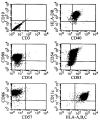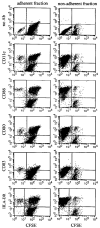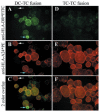Hybrids of dendritic cells and tumor cells generated by electrofusion simultaneously present immunodominant epitopes from multiple human tumor-associated antigens in the context of MHC class I and class II molecules
- PMID: 12734382
- PMCID: PMC2553207
- DOI: 10.4049/jimmunol.170.10.5317
Hybrids of dendritic cells and tumor cells generated by electrofusion simultaneously present immunodominant epitopes from multiple human tumor-associated antigens in the context of MHC class I and class II molecules
Abstract
Hybrid cells generated by fusing dendritic cells with tumor cells (DC-TC) are currently being evaluated as cancer vaccines in preclinical models and human immunization trials. In this study, we evaluated the production of human DC-TC hybrids using an electrofusion protocol previously defined for murine cells. Human DCs were electrically fused with allogeneic melanoma cells (888mel) and were subsequently analyzed for coexpression of unique DC and TC markers using FACS and fluorescence microscopy. Dually fluorescent cells were clearly observed using both techniques after staining with Abs against distinct surface molecules suggesting that true cell fusion had occurred. We also evaluated the ability of human DC-TC hybrids to present tumor-associated epitopes in the context of both MHC class I and class II molecules. Allogeneic DCs expressing HLA-A*0201, HLA-DR beta 1*0401, and HLA-DR beta 1*0701 were fused with 888mel cells that do not express any of these MHC molecules, but do express multiple melanoma-associated Ags. DC-888mel hybrids efficiently presented HLA-A*0201-restricted epitopes from the melanoma Ags MART-1, gp100, tyrosinase, and tyrosinase-related protein 2 as evaluated by specific cytokine secretion from six distinct CTL lines. In contrast, DCs could not cross-present MHC class I-restricted epitopes after exogenously loading with gp100 protein. DC-888mel hybrids also presented HLA-DR beta 1*0401- and HLA-DR beta 1*0701-restricted peptides from gp100 to CD4(+) T cell populations. Therefore, fusions of DCs and tumor cells express both MHC class I- and class II-restricted tumor-associated epitopes and may be useful for the induction of tumor-reactive CD8(+) and CD4(+) T cells in vitro and in human vaccination trials.
Figures




Similar articles
-
Generation of dendritic cell-tumor cell hybrids by electrofusion for clinical vaccine application.Cancer Immunol Immunother. 2004 Aug;53(8):705-14. doi: 10.1007/s00262-004-0512-1. Epub 2004 Mar 26. Cancer Immunol Immunother. 2004. PMID: 15048588 Free PMC article.
-
Retrovirally transduced human dendritic cells can generate T cells recognizing multiple MHC class I and class II epitopes from the melanoma antigen glycoprotein 100.J Immunol. 2001 Oct 15;167(8):4758-64. doi: 10.4049/jimmunol.167.8.4758. J Immunol. 2001. PMID: 11591807
-
Cell fusion: an approach to generating constitutively proliferating human tumor antigen-presenting cells.Cancer Immunol Immunother. 2002 Sep;51(7):367-75. doi: 10.1007/s00262-002-0295-1. Epub 2002 Jun 25. Cancer Immunol Immunother. 2002. PMID: 12192536 Free PMC article.
-
Antigen-presenting cells and the selection of immunodominant epitopes.Crit Rev Immunol. 1997;17(5-6):411-7. Crit Rev Immunol. 1997. PMID: 9419428 Review.
-
Conformational heterogeneity of MHC class II induced upon binding to different peptides is a key regulator in antigen presentation and epitope selection.Immunol Res. 2010 Jul;47(1-3):56-64. doi: 10.1007/s12026-009-8138-1. Immunol Res. 2010. PMID: 20066513 Free PMC article. Review.
Cited by
-
Optimization of dendritic cell loading with tumor cell lysates for cancer immunotherapy.J Immunother. 2008 Sep;31(7):620-32. doi: 10.1097/CJI.0b013e31818213df. J Immunother. 2008. PMID: 18600182 Free PMC article.
-
Cancer vaccine by fusions of dendritic and cancer cells.Clin Dev Immunol. 2009;2009:657369. doi: 10.1155/2009/657369. Epub 2010 Feb 18. Clin Dev Immunol. 2009. PMID: 20182533 Free PMC article. Review.
-
Semiallogenic fusions of MSI(+) tumor cells and activated B cells induce MSI-specific T cell responses.BMC Cancer. 2011 Sep 26;11:410. doi: 10.1186/1471-2407-11-410. BMC Cancer. 2011. PMID: 21943054 Free PMC article.
-
Exposure to the electrofusion process can increase the immunogenicity of human cells.Cancer Immunol Immunother. 2005 Sep;54(9):880-90. doi: 10.1007/s00262-004-0659-9. Epub 2005 May 31. Cancer Immunol Immunother. 2005. PMID: 15926080 Free PMC article.
-
Interleukin-7 gene-modified dendritic cells reduce pulmonary tumor burden in spontaneous murine bronchoalveolar cell carcinoma.Hum Gene Ther. 2003 Nov 1;14(16):1511-24. doi: 10.1089/104303403322495025. Hum Gene Ther. 2003. PMID: 14577913 Free PMC article.
References
-
- Banchereau J, Briere F, Caux C, Davoust J, Lebecque S, Liu YJ, Pulendran B, Palucka K. Immunobiology of dendritic cells. Annu. Rev. Immunol. 2000;18:767. - PubMed
-
- Mayordomo JI, Zorina T, Storkus WJ, Zitvogel L, Celluzzi C, Falo LD, Melief CJ, Ildstad ST, Kast WM, Deleo AB. Bone marrow-derived dendritic cells pulsed with synthetic tumour peptides elicit protective and therapeutic antitumour immunity. Nat. Med. 1995;1:1297. - PubMed
-
- Hsu FJ, Benike C, Fagnoni F, Liles TM, Czerwinski D, Taidi B, Engleman EG, Levy R. Vaccination of patients with B-cell lymphoma using autologous antigen-pulsed dendritic cells. Nat. Med. 1996;2:52. - PubMed
-
- Thurner B, Haendle I, Roder C, Dieckmann D, Keikavoussi P, Jonuleit H, Bender A, Maczek C, Schreiner D, Von Den DP, et al. Vaccination with mage-3A1 peptide-pulsed mature, monocyte-derived dendritic cells expands specific cytotoxic T cells and induces regression of some metastases in advanced stage IV melanoma. J. Exp. Med. 1999;190:1669. - PMC - PubMed
Publication types
MeSH terms
Substances
Grants and funding
LinkOut - more resources
Full Text Sources
Other Literature Sources
Research Materials

